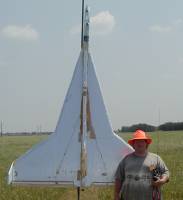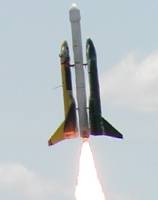R/C RBG Pages |
|
| | | | | |
 | Page 1 |  |
| Maxi Synchronicity #1 - F R/C R/G 59" span, 1990 The first Maxi-Synchronicity was built to go after the FAI duration record for F R/G, known as S8F. It was tested on as much as Chad-Staged D12/D12/D12 power. For the FAI record attempt, at NARAM-42, it flew on an F10. The record attempt flight was going well. It was in a nice thermal overhead, and going up. I let it get up too high, going out of sight at about 25 minutes into the flight. A couple of others saw it, and tried to help me steer it back in sight, but it ended up flying away. It was already close to setting the FAI record at the time I lost sight of it, so it would have easily set a new record. The model was never found. And, a few years later, the FAI changed the record setting rules so that a record can only be set during an actual FAI contest, and not an FAI record attempt. Maxi Synchronicity # 2 and #3 - F & G R/C R/G's 60" span, 1992 In preparing for NARAM-34, with G R/G, I built a similar model of about 60" span. One difference is that it was intended to fly on an Aerotech 32mm F13 or G12 reload, except for the contest flight when it would fly on an F10 and two A3's to nudge it into F power (would have preferred to use a G12, but reloads were not contest certified in 1992). Another difference was the Flagship/Synchronicity type built-up balsa fuselage was changed to a pod-and-boom type, using a fiberglass tailboom. On its first test flight, on an F13, it pitched nose down and crashed mysteriously. I did not realize at the time that the tailboom had been too weak. The pitch-down force of the engine thrust normally would be countered by up-elevator, until the model was near-vertical. But in this case, the boom bent down bit and full up elevator made the boom bend down even more. I did not realize this until a year or two later during a flying trip with Ed LaCroix in Phoenix, with another model built much the same, another fiberglass tailboom, that did exactly the same thing on boost. That was the LAST time I ever used fieberglass for a tailboom. I dod not have any photos of the first model that crashed in July 1992, so below is the other model that crashed in 1993 or 1994. | |
 Buried engine and fuselage pod |  Ed Lacroix at the impact zone |  Pieces laid out |
| So, for NARAM-34, I built a nearly identical model. I did not realize the tailboom had been the cause of the first model's crash, but fortunately built another Maxi-Synchronicity, #3, with an all balsa fuselage. That new bird, se nin the two photos below, flew very well in test and practice flights. On its first attempt in G R/G at NARAM-34 the F10 had a Cato. It did not hurt the model, just knocked the pod off. So after gluing the pod back on, it was put into the tower and readied to fly again. But the increasing winds and dry lakebed allowed the stake in the front of the pad to yank out, blowing the tower and model backwards, and crushed the glider. The fuselage was splintered. Even the wing was damaged, but the wing and tail were later used for the fiberglass boom model that crashed in Phoenix in 1993. Minutes later, flying was called for the day due to high winds and G R/G resumed the next day. But that bird's fuselage was toast. |
 Maxi-Synchronicity #3 and pieces of #2 before flight test in Huntsville |  Landing Maxi-Sync #3 after a practice flight at NARAM-34 |
| Raven-7 By Bob Parks - F & G R/G 60" Span 1992 Fortunately, I had a back-up model for NARAM-34. That was the Raven-7 by Bob Parks. Raven-7 was intended to be a second R/C R/G kit by Aerotech, alongside the Phoenix. Bob had asked me to build a prototype for feedback, providing a semi-kit, 32mm casing, and a few reloads for free... what a deal! So, I had built that earlier in 1992. It was designed to be able to hold up to as much as an F23, so it was strongly built, and a bit heavy compared to a similar model if it had been built to only fly on a G12. For G R/C in NARAM-34 I flew it first with an F10 plus a D12 that was air-started about 2 seconds into the F10 boost. The flight was good. For flight #2, I used an F10 with a second F10 air-started. I wanted the second F10 to ignite 1 second before the first F10 burned out. But, it ignited about 3 or 4 seconds into the boost, with 4 to 5 seconds over overlap, and with two F10's producing 20 Newtons of thrust, the Raven-7 got to REALLY moving fast, and starting to run out of up elevator to keep it vertical. Fortunately, the first F10 burned out and I got it back on track for the rest of the boost. The two flights easily gave our Southern Neutron Team first place. Raven-7 has flown a few times since then. It's best boosts have been when I have clustered a G12 and E6, for about 130 N-sec of "G18" power. For more info and plans for the Raven-7, go to the Raven Page. |  Raven-7 (with then-new 1/60 orbiter and Astro-Blaster) |
 Preparing for a practice flight at NARAM-34, with Jay Marsh. |  Note the white and yellow engine pod for air-started D12 or second F10. |
| Big Bird #1 - F & G R/C R/G 60" Span 1993 In preparing for a trip out to visit with Ed LaCroix in Phoenix, I built a new 60" span model to ship. Since a 60" wing was a problem, the wing was desined with a joiner system so the wing came apart in thirds. Plus, the stab was bolted on, so it could be removed for shipping. The whole model was able to fit into my wooden model box. I named it "Big Bird". The fuselage was all-balsa, like a Maxi-Synchronicity It worked out nicely. In fact, the week out there was the first time that Ed flew R/C R/G boosts. He had learned to fly a Gentle Lady Sailplane, then a beat-up old R/C B/G with a big long pod so he could do rocket boosts without having to control the boosts. For his first R/C R/G boost ,we used a buddy box system, but he handled the boost so well that he flew solo from then on. The photo at right was one of Ed's flights on Big Bird. Unfortunately Big Bird was wiped out in a crash at NSL. Ed took it there and flew it, but the elevator setting in the transmitter was opposite of what it needed to be, so Ed was unable to correct the boost. That was before either of us had computer transmitters with model memories, and incidents like that was one of the reasons we both moved to computer transmitters (I had my own "oops" incident when I did not reverse a rudder servo, causing a model to spiral into the ground after transition to glide. But at least it was repairable). | |
|
| Big Bird#3 - Rebuild (2003) NARAM-45 in 2003 had F Dual Eggloft Dur. again, so I rebuilt BB#3. I had to build a mostly new center section for the wing, but was able to salvage and graft on the outer 3" of each end of the original center section, which was critical since the original wing joiners were there. Also built a new V-tail for it. At that time the F10 had gone OOP, and was not contest certified, so the engine power had to be different for the contest flight. It was modified to use a cluster of one E9 and two C6's for liftoff, with a second E9 air-started 2 seconds after liftoff (using a 2-second Zitnan timer). The model flew great. Ryan Woebkenberg used an electric sailplane to find lift. The flight lasted for 1310 seconds, or 21 minutes and 50 seconds. It won Team division by a good margin. There was one other team that did fly an R/C EggGlider, Dan Miner's Shovel Recovery Team. VIDEO of big Bird-3 Boost (Chris Taylor) VIDEO of Dan Miner's EggGlider (Chris Taylor) |  Rebuilt BB#3 with 24mm Pod added for air-started E9 and Zitnan timer |  Close up of 32mm engine mount and two 18mm pods added for C6's |
| Full Circle - Great Dane Swing-Wings from 1972 and 2006 In 1972, I built a 6.5 foot wingspan swing-wing B/G that I named "The Great Dane". Powered by 2-staged D12's in a pop-pod. It worked, but only lasted three flights. MANY more followed after, a few with 9.5 foot span, even one with 10.5 foot wingspan. In 1975, I had mentioned in a letter to Guppy Youngren that I wanted to get some of the micro pulse R/C gear to use in one of my Great Dane gliders. His letter in reply was to urge me to start out with R/C gear in something smaller and more reliable first. And it was good advice. In 1992, I built a new Great Dane model (The first since 1977) partly as a free-flight back-up for G R/G at NARAM-34. But the main reason was to build a working prototype model that some others could copy, such as Mark Hamilton and Tom Beach, who flew them on F10 power plus one or two mini-A's to nudge into G class (IIRC, Mark won in C Div, and Tom's team took second). In 2006, I finalyl did what I had wanted to do in 1975. I converted that 1992 Great Dane for rudder-only R/C. Except of course it was not using 1975-era old pulse gear, it was using modern micro R/C gear and a very tiny servo. The model flew GREAT on just a single D12, and boosted surprisingly well on staged D12's, much straighter than I expected. The handling control was very nice, for a rudder-only model. I added some lights and LED's to it to fly at the night launch at NARAM-49, but it was too windy so I did not fly it at night. Unfortunately, on a later flight at N-49, the wings failed to deploy, so it crashed. |
|




















